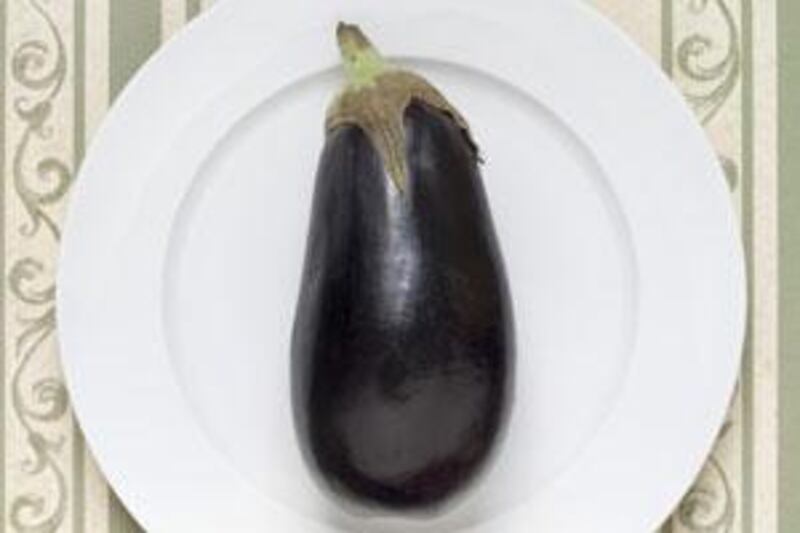The great sponge of the culinary world: it's not the most noble of titles, but it is descriptive. Ask anyone who has fried aubergine. Oops, there goes the oil. Aubergine, eggplant (as it's known in the US and Australia) or brinjal (its name in India, South Africa and Malaysia) is a sponge in the best sense of the word, absorbing the flavours of the world's cuisines. In France it's stewed for ratatouille; in Italy, it's grilled for eggplant parmesan; in Greece, it's chopped and simmered for moussaka; in Turkey it's deep-fried and topped with yogurt and in the Middle East it's roasted and mashed for baba ghanoush and moutabal.
"Aubergine is one of my favourites," says Suzanne Husseini, a participating chef in the show kitchen at the Abu Dhabi International Book Fair this week. "It's very much part of Arabic cuisine, and used in hundreds of dishes. In fact, it was the Arabs, coming across Persia, who brought the aubergine to Europe." Husseini, who says she finds these connections "fascinating", has read extensively on medieval Mediterranean cooking. "When you delve into food, you learn about a culture," says the Dubai chef, whose first cookbook, Everyday Arabic, will come out later this spring in English and Arabic from Motivate Publishing.
Husseini has her aubergine history right. Though the plants weren't introduced in the West until the 1500s, they were cultivated in prehistory in eastern and southern Asia. (China still produces more than 50 per cent of the world's crop.) Interestingly, they weren't embraced right away: they're related to the nightshade family, and people feared they were dangerous to eat. Western, or globe, aubergine is the most familiar variety. Dark purple with milky white, fruitlike flesh, it can be found year round, though its peak season is late summer. When shopping, look for shiny, smooth, unwrinkled skin - the aubergine should feel firm, springing back slightly when touched - and a stem that looks moist. Happily, aubergine is one of the few vegetables you don't have to worry about overcooking. To reach its full flavour and achieve a soft, creamy texture, you have to cook it completely through. Husseini's recipe below stars aubergine at its absorbent best.
Musaq'aa Husseini's take on this Greek classic features chickpeas in place of lamb mince and uses the aubergine - cut length-wise instead of width-wise - as a kind of edible envelope. "When I did my cooking show, some people - even my mother - were surprised that the ingredients were the same, but the presentation was different," says Husseini. "But who says something has to be in a round dish? Why not square?" What matters most, no matter the shape or ingredients, is that this is "something you make with your hands", she says. "It nourishes the soul."
This recipe also works well as a leftover, served cold, Husseini says. Serves 8. Ingredients 2 large aubergines 3 tbsp olive oil, plus a little extra for the baking tray 2 tbsp olive oil 6 garlic cloves, sliced thin 1 onion, chopped fine 1.5kg tomatoes, chopped 1 tbsp pomegranate syrup 1 tsp ground allspice 1 tsp ground cinnamon 2 tbsp caster sugar salt & pepper to taste 1 can chickpeas, rinsed and drained
65g pine nuts, toasted 15g fresh mint, chopped Method Preheat the oven to 230°C. Line a large baking tray with aluminium foil and brush lightly with olive oil. Peel the aubergines and cut them length-wise (about 1cm thick). Brush both sides of the long slices with the 3 tbsp of olive oil and place them on the baking tray. Roast until golden brown, about 20-25 minutes. Remove and cool, easing a spatula underneath as they cool so they don't stick to the pan.
In a large frying pan, heat the 2 tbsp of olive oil. Add the garlic and onions and sauté until soft and translucent. Add the chopped tomatoes, pomegranate syrup, allspice, cinnamon, sugar, salt and pepper. Allow to come to a boil. Add the drained chickpeas to the tomato sauce. Lower the heat and leave to simmer and thicken slightly (about five minutes.) Stir in half the pine nuts. Set aside the rest.
To serve, place one roasted slice of aubergine on a plate and spoon the tomato sauce on the slightly wider side. Fold over to cover the filling. Continue with the other slices. Garnish with chopped mint and the remaining pine nuts. Serve with a salad or rice, or both.





